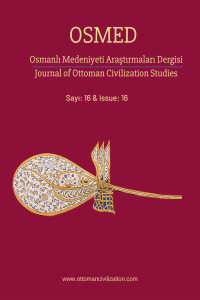Remzi Kılıç, Osmanlı Yönetiminde Irak ve Suriye [Tarihî Coğrafyası - XIX. Yüzyılda İdarî Yapısı], İdeal Kültür Yayınları, İstanbul 2011
Abstract
Genel olarak Ortadoğu; yerleşik medeniyetlerin kurulduğu, hayvancılığın başladığı, tarımın öne çıktığı, astronomik hesaplar ve sulama kanalları ile sistemleştiği, ilk devletlerin ve savaşçı imparatorlukların kurulduğu, yazının icat edilip kullanıldığı, ilk kanunların yazıldığı, ilk antlaşmaların imzalandığı, ticaretin ve ekonominin geliştiği, tek tanrılı dinlerin ortaya çıktığı ve ilk inanç yapılarının yükseldiği bir alan olmuştur.
Tanıtımı yapılan çalışmada; konular özlü bir şekilde ele alınmış, alanında konuyla ilgili temel kaynaklar kullanılarak zengin bir akademik literatürle hazırlanmış; Irak ve Suriye toprakları XIX. yüzyılın sonlarındaki idarî taksimatı göz önünde bulundurularak ‘Tarihî Coğrafya’ açısından akademik bir perspektiften incelenmiştir.
Keywords
Osmanlı Devleti Suriye Irak Tarihî Coğrafya İdarî Taksimat. Osmanlı Devleti, Suriye, Irak, Tarihî Coğrafya, İdarî Taksimat.
References
- Kılıç, Remzi. (2011). Osmanlı Yönetiminde Irak ve Suriye (Tarihî Coğrafyası - XIX. Yüzyılda İdarî Yapısı), İstanbul: İdeal Kültür Yayınları.
Remzi Kılıç, Osmanlı Yönetiminde Irak ve Suriye [Tarihî Coğrafyası - XIX. Yüzyılda İdarî Yapısı], İdeal Kültür Yayınları, İstanbul 2011
Abstract
The Middle East, in general, is the only place where settled civilizations were established, animal husbandry began, agriculture came to the fore, astronomical calculations were made and irrigation channels became systematic, the first states and warlike empires were established, writing was invented and used, the first laws were written, the first treaties were signed, trade and economy developed, It has been an area where godly religions emerged and the first belief structures were raised.
In this study, the subjects were handled concisely and prepared with profound academic literature using primary sources on the subject, considering the administrative division at the end of the XIX. century perspective which is light on Iraq and Syria were examined from an academic perspective in terms of 'Historical Geography'.
References
- Kılıç, Remzi. (2011). Osmanlı Yönetiminde Irak ve Suriye (Tarihî Coğrafyası - XIX. Yüzyılda İdarî Yapısı), İstanbul: İdeal Kültür Yayınları.
Details
| Primary Language | Turkish |
|---|---|
| Subjects | History of The Social Sciences |
| Journal Section | Book Review |
| Authors | |
| Publication Date | March 30, 2023 |
| Submission Date | December 22, 2022 |
| Acceptance Date | January 30, 2023 |
| Published in Issue | Year 2023 Issue: 16 |
Indexes
SCOPUS, TÜBİTAK/ULAKBİM TR DİZİN [SBVT]
INDEX COPERNİCUS [ICI], ISAM, SOBIAD and Scilit.

Unless otherwise stated, the articles published in our magazine are licensed under the Creative Commons Attribution 4.0 International (CC BY 4.0) license. All authors and translators who submit texts for publication in the journal are expected to be the sole copyright holders of the submitted text or to have obtained the necessary permissions. By submitting texts to the journal, authors and translators implicitly accept that these texts will be licensed under CC BY 4.0 unless explicitly stated otherwise to the editors at the outset.


